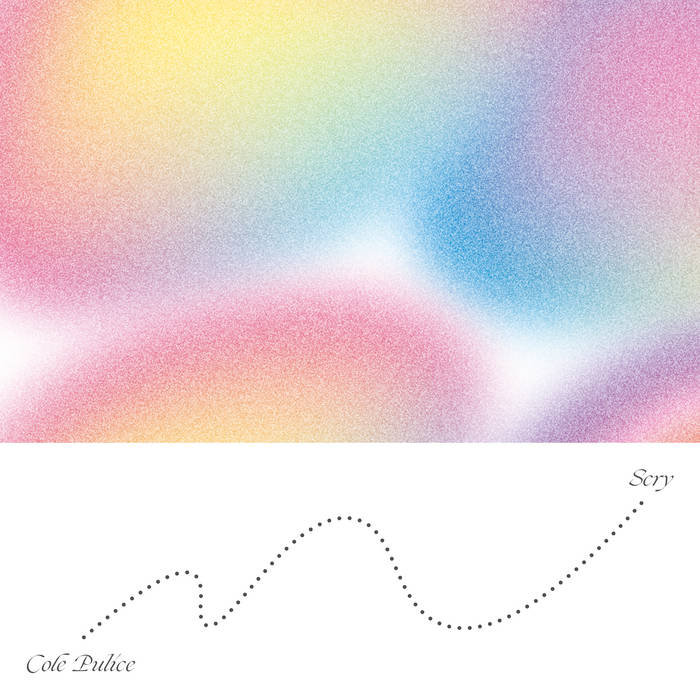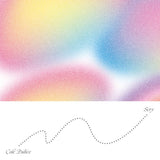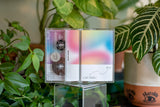Cole Pulice // Scry TAPE
- Availability:
アメリカ・カリフォルニアのサックス奏者Cole Puliceが、2022年12月に同国オレゴンのポストニューエイジレーベルMoon Glyphからリリースしたカセットです。
ピアノとサックスによるアンビエントジャズ8曲を収録。
※デジタル音源を無料でお送りいたしますのでお気軽にご連絡くださいませ
レーベルその他作品はこちら /// Click here to see more Moon Glyph releases available at Tobira.
------------------------------
Ask us for digital files. Cassette in norelco case.
Tracklist:
1. HP / MP 01:11
2. Astral Cowpoke 06:03
3. Driftglass 01:15
4. City in a City 05:47
5. Moon Gate Rune 01:05
6. Glitterdark 03:23
7. Spool 02:12
8. Scry 07:31
Moon Glyph:
"Cole Pulice is a composer, saxophonist and electroacoustic musician from Oakland-via-Minneapolis. Following their debut album "Gloam" and two duo collaborations with Lynn Avery and Nat Harvie, Cole Pulice returns with their sophomore album "Scry". The sound is deeply contemporary, incorporating saxophone/wind synth with live signal processing and modern electronics/software. It drifts between electroacoustic experimentalism and more traditional forms of song-like beauty, casting a wide sonic net that highlights Pulice’s versatility and creativity as both an improviser and composer.
From Cole:
"Scry is a collection of musics exploring fragmentary or gradient states of liminality – recursive spirals of worlds hidden within worlds, dreams within dreams, sensations of time, and the notion of the past, present, and future all occupying a single point.
It’s a record that, for me, resonates strongly with this sort of “between-ness:” it began in Minneapolis, and was finished in Oakland, bridging pre-pandemic life with the “new normal” of current times; being genderqueer and navigating the spaces between and outside of the masculine and feminine binary; wandering through a musical interchange station that is interconnects improvisation, “song,” and collage experiments . . . multidimensional yet woven together by similar aesthetic threads.
Whereas my previous record, Gloam, was mostly a series of compositions for a very specific electroacoustic setup, Scry utilizes a series of different hardware/software frameworks and apparatus. Or, to think of it in another way: Gloam was like looking through a kaleidoscope (each turn of the handle giving a different abstract perspective of the same bits of gemstone); Scry is more like a stained-glass crystal ball (a singular sculpture, with each fragment somehow offering an ephemeral glimpse into another world or dimension).
Scry is deeply indebted to the electroacoustic works of Pauline Oliveros, David Behrman, Marion Brown, Maggi Payne, Harold Budd, and Jon Hassell - all of whom explored, in their own ways, the interconnectivity between acoustic instruments, interactive electronic signal processing, and improvisation - the crux of ‘Scry’s DNA. To this end: virtually all of the signal processing on ‘Scry’ is done live as I play saxophone/wind synth, either through a hardware setup that I control with my feet as I play, or through software instruments I build which respond live to what I’m playing. Often, both software and hardware processes are being used simultaneously.
"To scry" defines the practice of foretelling the future through gazing into a crystal ball or other reflective surfaces. There's a lot to say here regarding the mix of temporalities, timelines, states of being, and so forth, but I mostly just have to give a special thanks to glass artist, composer, and dear friend Sadie Robison. The arcane aesthetics of her technicolor stained glass sculptures were a major influence on the themes of Scry"
Artist : Cole Pulice
Label : Moon Glyph
アメリカ・カリフォルニアのサックス奏者Cole Puliceが、2022年12月に同国オレゴンのポストニューエイジレーベルMoon Glyphからリリースしたカセットです。
ピアノとサックスによるアンビエントジャズ8曲を収録。
※デジタル音源を無料でお送りいたしますのでお気軽にご連絡くださいませ
レーベルその他作品はこちら /// Click here to see more Moon Glyph releases available at Tobira.
------------------------------
Ask us for digital files. Cassette in norelco case.
Tracklist:
1. HP / MP 01:11
2. Astral Cowpoke 06:03
3. Driftglass 01:15
4. City in a City 05:47
5. Moon Gate Rune 01:05
6. Glitterdark 03:23
7. Spool 02:12
8. Scry 07:31
Moon Glyph:
"Cole Pulice is a composer, saxophonist and electroacoustic musician from Oakland-via-Minneapolis. Following their debut album "Gloam" and two duo collaborations with Lynn Avery and Nat Harvie, Cole Pulice returns with their sophomore album "Scry". The sound is deeply contemporary, incorporating saxophone/wind synth with live signal processing and modern electronics/software. It drifts between electroacoustic experimentalism and more traditional forms of song-like beauty, casting a wide sonic net that highlights Pulice’s versatility and creativity as both an improviser and composer.
From Cole:
"Scry is a collection of musics exploring fragmentary or gradient states of liminality – recursive spirals of worlds hidden within worlds, dreams within dreams, sensations of time, and the notion of the past, present, and future all occupying a single point.
It’s a record that, for me, resonates strongly with this sort of “between-ness:” it began in Minneapolis, and was finished in Oakland, bridging pre-pandemic life with the “new normal” of current times; being genderqueer and navigating the spaces between and outside of the masculine and feminine binary; wandering through a musical interchange station that is interconnects improvisation, “song,” and collage experiments . . . multidimensional yet woven together by similar aesthetic threads.
Whereas my previous record, Gloam, was mostly a series of compositions for a very specific electroacoustic setup, Scry utilizes a series of different hardware/software frameworks and apparatus. Or, to think of it in another way: Gloam was like looking through a kaleidoscope (each turn of the handle giving a different abstract perspective of the same bits of gemstone); Scry is more like a stained-glass crystal ball (a singular sculpture, with each fragment somehow offering an ephemeral glimpse into another world or dimension).
Scry is deeply indebted to the electroacoustic works of Pauline Oliveros, David Behrman, Marion Brown, Maggi Payne, Harold Budd, and Jon Hassell - all of whom explored, in their own ways, the interconnectivity between acoustic instruments, interactive electronic signal processing, and improvisation - the crux of ‘Scry’s DNA. To this end: virtually all of the signal processing on ‘Scry’ is done live as I play saxophone/wind synth, either through a hardware setup that I control with my feet as I play, or through software instruments I build which respond live to what I’m playing. Often, both software and hardware processes are being used simultaneously.
"To scry" defines the practice of foretelling the future through gazing into a crystal ball or other reflective surfaces. There's a lot to say here regarding the mix of temporalities, timelines, states of being, and so forth, but I mostly just have to give a special thanks to glass artist, composer, and dear friend Sadie Robison. The arcane aesthetics of her technicolor stained glass sculptures were a major influence on the themes of Scry"
Artist : Cole Pulice
Label : Moon Glyph







